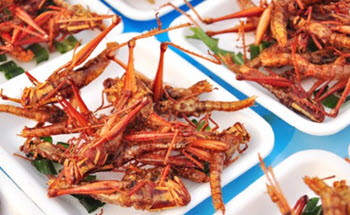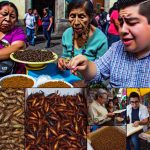The study Energy-efficient food production to reduce global warming and ecodegradation: The use of edible insects reports that insect cultivation can be more than 10 times as efficient as traditional livestock production, if we look at how much plant nutrients that are needed to produce 1kg of food.
 Animals that keep a steady body temperature – such as cattle, pigs and chickens – need a lot of calories simply to maintain this temperature unless they are farmed in very warm conditions. Insects on the other hand are ectothermic and can use more their food to grow, since they don’t use it to maintain their body temperature. Of course, that also means that temperature must be taken into account when planning insect farming. Many insects can not survive in cool conditions or will hibernate and stop growing if the temperature drops too low.
Animals that keep a steady body temperature – such as cattle, pigs and chickens – need a lot of calories simply to maintain this temperature unless they are farmed in very warm conditions. Insects on the other hand are ectothermic and can use more their food to grow, since they don’t use it to maintain their body temperature. Of course, that also means that temperature must be taken into account when planning insect farming. Many insects can not survive in cool conditions or will hibernate and stop growing if the temperature drops too low.
The efficiency of conversion of ingested food to body substance (ECI) is roughly 10 for cattle. For the German cockroach (Blattella germanica), it is well above 40. Silkworms, traditionally cultivated in China and neighboring regions, typically have an ECI in the 20-30 span.
There are many insects with a measured energy input to protein output ratio of around 4:1. For raised livestock, this ratio is typically well above 50:1.
Water
Successful grasshopper and cricket farming is possible to achieve with less water than whats required for successful cattle production. According to an article in Time Magazine, a whopping 3,290 liters of water is needed to produce 150 grams of beef. Naturally, these numbers will vary depending on how the beef is farmed, just like the amount of water needed for insect farming will vary. Still, insects such as grasshoppers and crickets are usually much more “water efficient” than cattle.
Livestock doesn’t just consume water, they also help pollute freshwater resources. In the United States, one third of the loads of nitrogen and phosphorus into freshwater resources comes from livestock. Certain species of grazing livestock even have a negative impact on the replenishment of freshwater since they compact the soil, thereby reducing infiltration.
Land use
 Right now, over 25% of the earth’s ice-free terrestrial surface is occupied by grazing animal livestock. Also, one-third of total arable land is used to grow food for livestock instead of growing food for direct human consumption. All in all, 70% of the planet’s agricultural land is used for livestock production.
Right now, over 25% of the earth’s ice-free terrestrial surface is occupied by grazing animal livestock. Also, one-third of total arable land is used to grow food for livestock instead of growing food for direct human consumption. All in all, 70% of the planet’s agricultural land is used for livestock production.
Insect farming could be a more efficient way of growing protein-rich food, but that would largely depend on the methods used to obtain food for the insects.
Reproduction
In four weeks, a female cricket can lay up to 1,500 eggs. In farming conditions, the hatching and survival rate for this offspring can be drastically increased compared to the wild.
This can be compared to a cow, who will typically only give birth to one or two calves per year. The gestation period is roughly nine months, after which she typically gives birth to one or two calves.
Of course, calculations regarding cricket farming must take into account that an individual cricket is much smaller than an individual cow.
A benefit of farming many small animals instead of a few large one is the increased potential for risk diversification. Cricket offspring can be divided into groups and raised in separate containers, to ensure that negative issues such as infectious disease or parasites that impact one group doesn’t spread to the others.
Carbon dioxide
Researchers at the University of Wageningen analyzed the carbon dioxide production per kilogram of mass gain for five insect species; three that are currently eaten and two that have shown potential for mass cultivation and protein extraction.
 Fifth larval stage mealworms Tenebrio molitor
Fifth larval stage mealworms Tenebrio molitor- Fifth and sixth nymphal stage house crickets Acheta domesticus
- Third and fourth stage nymphs of migratory locusts Locusta migratoria
- Third larval stage sun beetles Pachnoda marginata
- A mix of all stages of the Argentinean cockroach Blaptica dubia
The CO2 production per kg of mass gain for the five insect species in the current study was 39% – 129% to that of pigs and 12% – 54% to that of beef cattle. These wide spans show that it is important to consider the carbon dioxide production of individual species, rather than just assume that all insects are a much better choice and pig farming.
Obstacles – how will we feed the insects?
When insects are hailed as an environmental savior, it is often assumed that they will be raised on food waste and similar resources. But so far, most large-scale commercial insect farming involve feeding the insects farmed grains, which makes the insect farming similar to raising livestocks such as grain-fed chicken and grain-fed cattle.
From an environmental aspect, raising insects on grains instead of raising chickens and cows on grains is only an improvement if switching to insects actually makes the farming more resource-efficient. To put it simple, it is only beneficial if using 100 grams of grain and 100 grams of water to raise insects would give me more food than what I would get from using 100 grams of grain and 100 grams of water to raise chicken or cattle.
 While switching the insect farming industry from grain-feed to more sustainable feeds such as household waste seems like a perfect solution, it is not without issues. The quality of the feed will impact insect yields and the quality of the food produced.
While switching the insect farming industry from grain-feed to more sustainable feeds such as household waste seems like a perfect solution, it is not without issues. The quality of the feed will impact insect yields and the quality of the food produced.
In 2015, results of the study “Crickets Are Not a Free Lunch: Protein Capture from Scalable Organic Side-Streams via High-Density Populations of Acheta domesticus” was published in the journal PLOS ONE.
In this study, researchers measured the biomass output and feed conversion ration of house crickets (Acheta domesticus) reared on diets that varied in quality, ranging from grain-based to highly cellulosic diets. The crickets were harvested after two weeks.
The study showed that biomass accumulation was strongly impacted by the quality of the diet. The three most important factors were nitrogen content, crud fat content, and the diet’s ratio of nitrogen to acid detergent fiber.
- In the group of crickets that were fed minimally-processed, municipal-scale food waste and had diets composed largely of straw, almost all individuals (>99%) died before reaching harvestable size.
- Crickets fed solid filtrate from food waste processed at an industrial scale via enzymatic digestion were able to reach a harvestable size, but their protein conversion rate was not better than that of farmed chickens.
- The most successful groups was the one where the crickets were fed a grain-based diet similar to commonly available commercial poultry-feed. However, the protein conversion rate for these crickets was only 35%, which is only slightly above that for farmed chickens on such a diet.
“I’m all for exploring alternatives, and I am impressed by the amount of innovation that has sprung up around insect cultivation and cuisine in the last few years,” commented Mark E. Lundy, one of the study researchers. “However, I also think we need to be clear-eyed about what the sustainability gains are and aren’t, and focus our innovative efforts and limited resources to where they will have the most lasting impact.”
Pest harvesting
Pest harvesting is a proposed alternative to the use of insecticides to control agricultural pests, such as grasshoppers. Using pesticides to promote the growth of crops is in a way a great waste of protein.
Example: We grow a crop that contains less than 15% protein. It is attacked by insects that contain 70% protein. Using pesticides is thereby a way of destroying food containing 70% protein just to get food that contains 15% protein. Is the amount of crop yielded per acre really large enough to justify this, when compared to the amount of insects that acre could yield?
In parts of Mexico, a grasshopper known as Chapulín de milpa (Phenarium purpurascens) is harvested for human consumption rather than fended off with pesticides. Farming families eat the grasshopper or sell them, with some families in earning upwards $3,000 per harvest this way.

